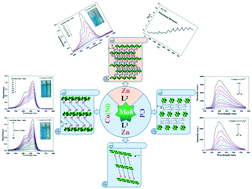Various types of isopolymolybdate-based metal–organic complexes formed in different conditions: synthesis, structures, luminescence, electrochemical, and photocatalytic performances†
Abstract
Under the regulation of different metal ions and organic ligands, five isopolymolybdate-based complexes, namely, [CoL10.5(Mo3O10)(H2O)2]·2H2O (1), [NiL10.5(Mo3O10)(H2O)2]·2H2O (2), [ZnL1(H2O)3][γ-Mo8O26]0.5 (3), [CdL11.5(θ-Mo8O26)0.5]·2H2O (4), and [ZnL2(Mo3O10)]·H2O (5) (L1 = 1,4-bis(1H-pyrazole-4-carboxamide)p-phenylene, L2 = 1,2-bis(1H-imidazole-4-carboxamido)ethyl) were prepared under hydrothermal/solvothermal conditions. Complexes 1, 2, and 4 were obtained under solvothermal conditions. 1 and 2 were isostructural, composed of [M2L1(H2O)4]4+ (M = CoII/NiII) cationic units and [Mo3O10]n2n− polymolybdate chains. In the presence of Cd ions, the 2D network structure of 4 was constructed from the [θ-Mo8O26]4− anions bridged by metal–organic belts. Both 3 and 5 were isopolymolybdate-based ZnII-complexes synthesized under hydrothermal conditions except for the difference of organic ligands and pH, namely, L1 acted as the ligand and the pH was 3.5 for 3, but they were L2 and 3.4 for 5, respectively. Complex 3 had a 2D supramolecular structure containing cationic units ZnL1(H2O)32+ and 1D infinite inorganic chains [γ-Mo8O28]n. In 5, the 1D convergent chains [Mo3O10]n were connected by binuclear metal–organic cationic rings [Zn2L22]4+ to form a 2D structure. The solvent ratio and reaction pH had a great influence on the synthesis of the title complexes, and metal ions and ligands played important roles in regulating the diversity of the polymolybdates and the structures of the complexes. The electrochemical, luminescence, and photocatalytic degradation properties for MB of the title complexes were investigated.



 Please wait while we load your content...
Please wait while we load your content...